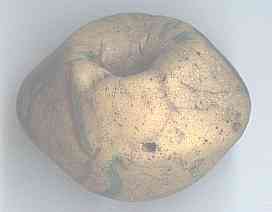The Bead SiteHome>Bead Names>Africa > Bodom and Akosu
Bodom and Akosu
Two of the most highly valued beads in West Africa are the Bodom and the Akosu. The Bodom is a treasured bead of the Asante (Ashanti), a dominant people in Ghana, while the Akosu is an important bead of the Ewe, who live in Togo and adjacent Ghana (see map below). Both are beads of kings.
The Bodom, in particular, has received considerable attention, even being the subject of two recent articles (Stanfield 2000-2001; Liu et al. 2001). Most of the article by Liu et al
is technical, but much of Standfield's attempts to demonstrate that the Bodom were made by the Krobo of Ghana.
|
There is also the testimony of the Asante themselves. When Daaku (1969: 266, 315) interviewed the Adanse (who claim to be the original Asante), informants in all 16 villages acknowledged the importance of Bodom and in 12 (3/4s) said that the beads came from the north The same thing was reported by the Asante of Asokore-Koona, who said that Bodom came from north of Jenné in the interior Niger delta (Meyerowitz 1951: 50, n. 2). See map below.
Bodom are probably very old, though we do not have sufficient information to date them. The interplay of traders from ancient Mali (including modern Mauritania and Mali), sometimes called Mandingo people, was an important element in the development of the Asante, due to the trans-Saharan trade for gold with Arab North Africa (Wilke 1961).
|
Given the antiquity of wet-core powder-glass beadmaking in the ancient overlapping kingdoms of Ghana (cross-hatched on the map above) and Mali (vertical stripes)
and given the testament of the Asante, an origin in or near one of the great cities of these two kingdoms makes perfect sense.
While the Krobo call some of their beads "Bodom," the term is new to them,
apparently introduced by Alastair Lamb in the early 1970s. Their beads are made by the
dry powder-glass method, often by forming two halves and joining them.
This is not the origin of true Bodom.
|
Daaku, Kwame Y.
1959 Oral Traditions of Adanse. Legon: Institute of African Studies, University of Ghana.
Lamb, Alastair
1976 Krobo Powder-Glass Beads. African Arts 9(3): 13-39, 93.
Liu, Robert K., Peter M. Ahn and Dudley Giberson
2001 Bodom and Related Beads: Investigating African powder-glass technology.
Ornament 25(2): 28-33.
Meyerowitz, Eva L. R.
1951 The Sacred State of the Akan. London: Faber and Faber
Stanfield, Kirk
2000-2001 The Krobo and Bodom. Beads 12/13: 63-76.
Wilks, Ivor
1961 The Northern Factor in Ashanti History: Begho and the Mande.
Journal of African History 2(1): 25-34.
__________________________________________________
Small Bead Businesses | Beading & Beadwork | Ancient Beads | Trade Beads
Beadmaking & Materials | Bead Uses | Researching Beads | Beads and People
Center for Bead Research | Book Store | Free Store | Bead Bazaar
Shopping Mall | The Bead Auction | Galleries | People | Events
The Bead Site Home | Chat Line | Contact Us | Site Search Engine | FAQ



